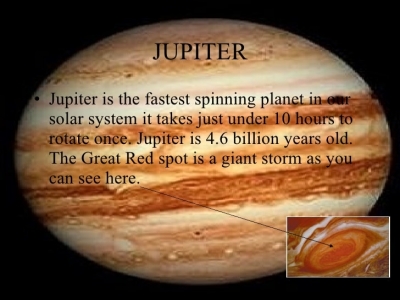
Jupiter is the fastest spinning planet in our Solar System rotating on average once in just under 10 hours. That is very fast especially considering how large Jupiter is. This means that Jupiter has the shortest days of all the planets in the Solar System.
Jupiter is the 5th planet from the sun and it is the biggest of all planets in the solar system. It is a giant gaseous planet and about 2.5 times the size of all planets combined in the solar system. It spins on its axis in the opposite direction as opposed to most planets. Other gas planets include Saturn, Uranus, and Neptune. Jupiter is believed to have a solid core made of rocks. Like most other planets, Jupiter does not have a defined solid surface. As a result of its rotation, the planet has an oblate spheroid shape having a bulge along the equator. The atmosphere of the planet is divided into different bands that vary with the altitude. At the boundaries are great turbulence and storms and the popular one is the Great Red Spot; a giant storm, which was first observed in the 17th century using a telescope. Because the surface of the planet is not solid, the rotational speed around the equator is different from that of its polar areas, and this is why it has a bulge at its equator. The rotational speed at the equator of this planet is 28,273 miles per hour. A complete day in Jupiter around the poles is an estimated nine hours and 56 minutes while at the equator it is an estimated nine hours and 50 minutes.
Jupiter is made up of 92% hydrogen and 8% of helium in the volume by gas composition, while by mass, its atmosphere is comprised of about of 75% hydrogen and 25% helium. In comparison to the planet Earth, Jupiter is massive but has low density. Jupiter has three rings around it and other moons, which orbit around it as well. The planet has faint narrow rings, which are dark and made of dust and rock fragments. Unlike the rings of Saturn, the rings of Jupiter are constantly losing materials and being replenished with the dust from other tiny meteors hitting the four inner moons. Jupiter has about 69 moons, which include four large moons that were discovered in 1610 by Galileo and they are known as Galilean moons. The largest of the four moons is the Ganymede, which has a larger diameter than planet Mercury. The Jupiter’s rings have three sections namely halo, main, and Gossamer rings.
Credit : World Atlas
Picture Credit : Google




